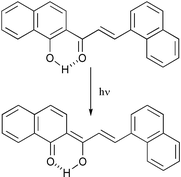Photoinduced hydrogen atom transfer in trans-1-(1′-hydroxy-2′-naphthyl)-3-(1-naphthyl)-2-propen-1-one
Abstract
trans-1-(1′-Hydroxy-2′-naphthyl)-3-(1-naphthyl)-2-propen-1-one (trans-NHC) exhibited a fluorescence spectrum (λmax
= 650 nm) with a large Stokes shift (10,500 cm−1) in


 Please wait while we load your content...
Please wait while we load your content...